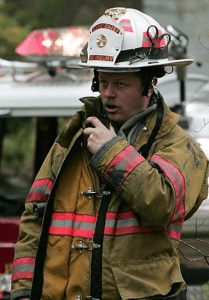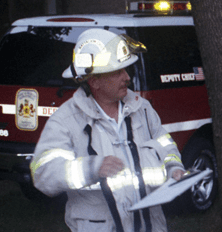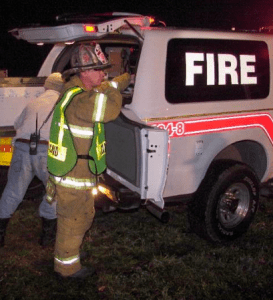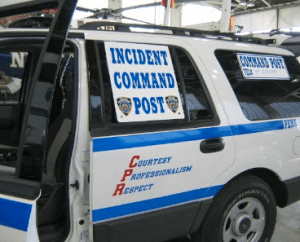 I recently read, with great interest, a very long thread on Facebook about whether or not an incident commander should wear turnout gear at a fire scene. As my focus and passion is improving first responder situational awareness, I would like to address this issue from that perspective.
I recently read, with great interest, a very long thread on Facebook about whether or not an incident commander should wear turnout gear at a fire scene. As my focus and passion is improving first responder situational awareness, I would like to address this issue from that perspective.
The feedback on Facebook was, as expected, all over the place with some participants saying the commander should be in turnout gear. Some said the commander should not be in turnout gear. And some displayed the typical (and expected) disdain for management and saying the chiefs should just stay in their offices. Editorial comments lacking maturity aside, the question of whether an incident commander should wear turnout gear is one I field often during my Fifty Ways to Kill a First Responder program so I thought I’d take the matter up here.
There are, essentially, two fundamental issues at hand:
- Should the incident commander be close enough to the hazards to require turnout gear?
- Should the incident commander set the example for others by wearing turnout gear?
Command Location
The location of the commander and his or her proximity to the hazards should dictate the need for the structural firefighting protective ensemble. If the commander is going to be close enough to require gear for protection, then gear should be worn. That one seems  simple.
simple.
But should the incident commander be that close to the action? That question perhaps gets more to the heart of the issue. Speaking from the perspective of brain science and situational awareness, there are some fundamental things to know before this can be debated:
- By definition, an incident commander must be far enough back from the action to be able to see the big picture incident in order to develop and maintain situational awareness.
- The cognitive demands (i.e., brain capacity) needed to command an emergency incident with multiple companies working are enormous. In many instances, these demands use all the commanders’ brain capacity.
- A commander who is close to the action may feel compelled to become ‘hands-on’ which can impact his or her ability to command. Being hands-on causes the commander to be task oriented, not big picture oriented. Being hands-on also requires some of the commander’s limited cognitive capacity (brain power) to perform the hands-on task. This can diminish the commander’s ability to process and comprehend important command-level information.
- Under stress, people become creatures of habit (see the earlier article entitled “Creatures of Habit“). If a commander has spent years serving as a hands-on firefighter (and let’s hope he or she has), under stress there may be a compelling urge to perform hands-on activities. Being close to the action and being donned in the protective gear may be enough to facilitate hands-on action. It’s a psychological thing.
In the seat or in the street?
I also get asked an awful lot about whether the commander should be situated in a vehicle or outside a vehicle. This is a hotly debated topic. Those who command from inside a vehicle (I’ll call them seat commanders) have a list of reasons why they prefer to be located there. Likewise, those who command from outside a vehicle (I’ll call them street commanders) also have a list of reasons why they prefer to be located in the street.
I am not the one to serve as the judge on where best to command from. First and foremost, I’d say command from where you are most comfortable… from the position that taps and uses your command abilities and intuition to their fullest. I will, however, make some observations based on my research and interviews with experienced commanders.
Seat Commander Advantages
- The commander will be in a physical position that will likely reduce distractions and interruptions which are significant barriers to situational awareness.
- The commander will be exposed to less noise which can improve the ability to hear radio traffic, improving situational awareness.
- The commander will not be in a position to become hands-on, which improves the dedication of cognitive resources to the act of commanding which improves situational awareness.
- The commander is in an environment of controlled light and temperature. Diminished environmental comforts can impact situational awareness.
- The commander is in an environment that improves access and use of technology such as mobile data computers, command boards and worksheets. Data management improves situational awareness.
Street Commander Advantages
- The commander is able to provide face-to-face instructions to scene personnel.
 This can reduce miscommunications and improve situational awareness.
This can reduce miscommunications and improve situational awareness. - The commander is mobile and able to physically see more of the incident. Capturing more clues and cues can improve situational awareness.
- The commander is in a physical position to use more senses to prompt intuition which can improve situational awareness.
- The commander is in a position to directly observe the physical stress and fatigue of personnel which can improve situational awareness.
- The commander is in a position of increased stress which, to some degree, can heighten awareness and improve performance.
My Personal Experience
I have commanded from both positions (seat and street) and have experienced, first hand, the advantages, and disadvantages of each.
Early in my career, I was a street commander and there was nothing anyone could have said to convince me otherwise. There was no way I was ever going to go sit in a car during a structure fire. I would have been so out of my element that I would have gone crazy. My comfort was being in and among the action.
However, as time passed and I was introduced slowly to the concept of being a seat commander and the advantages it provided to my effectiveness. I saw a marked improvement in my ability to hear my radio, in the reduction of distractions, in my ability to keep track of my personnel and (very importantly) my inability to think ahead of the incident. As reluctant as I was at first, I developed comfort and preference for being a seat commander.
Notwithstanding the occasional chiding I took from firefighters who thought sitting in the comfortable car while they were out in the elements was wimpy, I think they appreciated how my location directly impacted their safety.
Dr. Gasaway’s Advice
 If you are the incident commander, wear turnout gear at the right times and for the right reasons. This includes while working in an environment where your health and wellness might be adversely impacted if you were not in turnout gear.
If you are the incident commander, wear turnout gear at the right times and for the right reasons. This includes while working in an environment where your health and wellness might be adversely impacted if you were not in turnout gear.
Wearing turnout gear to set an example is not a good explanation for why an IC should don gear that can be hot and uncomfortable. Let a football coach be an example. The coach stays on the sidelines and coaches the team to success. The coach does not wear the uniform of the players. The coach does not need a helmet and shoulder pads to be effective. In fact, it might impede effectiveness.
Players who have the mindset that leaders set poor examples by not wearing gear are struggling with understanding the role of the commander. A commander who feels he or she must wear turnout gear to set a good example may be struggling to understand the role of the commander as well.
On a side note, many times when firefighters die in structure fires, the commander is performing hands-on activities… not commanding in a position to see the big picture.
 Action Items
Action Items
1. Does your commander wear turnout gear while commanding an incident? If so, why? If not, why?
2. Have you ever observed an incident commander being hands-on during an incident? What impact did it have on their effectiveness? Did it have an impact on the safety of personnel?
3. What are some tips a department can use to help responders and commanders understand the importance of each role on an incident scene and the benefits for the commander to be out of the action and not in turnout gear?
_____________________________________________________

If you are interested in taking your understanding of situational awareness and high-risk decision making to a higher level, check out the Situational Awareness Matters Online Academy.
CLICK HERE for details, enrollment options and pricing.
__________________________________
Share your comments on this article in the “Leave a Reply” box below. If you want to send me incident pictures, videos or have an idea you’d like me to research and write about, contact me. I really enjoy getting feedback and supportive messages from fellow first responders. It gives me the energy to work harder for you.
Thanks,

Email: Support@RichGasaway.com
Phone: 612-548-4424
SAMatters Online Academy
Facebook Fan Page: www.facebook.com/SAMatters
Twitter: @SAMatters
LinkedIn: Rich Gasaway
Instagram: sa_matters
YouTube: SAMattersTV
iTunes: SAMatters Radio
iHeart Radio: SAMatters Radio


With the improvements with technology those that are committed street commanders and are able to effectively manage the incident may consider utilizing a wireless headset. This will afford you the ability to block out external noise and your able to hear the radio clearly.
I have been both a street and seat commander depending on the situation. The wireless headseat resource can be utilized in either command environment.
Great suggestion. This serves two purposes. It not only reduces interruptions from noise, it also improves the ability of the commanders to hear critical radio traffic from companies working in IDLH environments. Thanks, Chief, for the recommendation.
Rich
I have had many converstation about this very topic. My own opinion reflects most of the comments in the article. I believe that if fully geared up, there is that tendancy to migrate further into the scene and end up finding yourself in the hot zone.
I do believe that wearing PPE provides a level of identity for the command officer. So in alot of instances, myself and others, wear our turnout coat and helmet.
And of course there are times due to weather issues (cold) full gear is worn just for the sake of staying warm
Yes, I have watched an incident commander become involved in tactical operations. I would be lying if I said I never did. With luck, the outcomes mostly were good. But I have seen instances where the IC becoming involved in tactical operations essentially left the IC role unstaffed because the IC was now engaged in ops and not paying attention to being an IC… i.e: radio traffic, situation awareness, coordination of units, etc.
Thanks for sharing your perspective Ron. Being able to identify the commander and sector/division officers is important. It is also very important that the commander be free of the distractions of weather. Being excessively hot or cold will impact situational awareness. Thanks for sharing.
I too used to be a street commander and I too was pulled into situations where I should not have been. I was distracted by other chiefs, officers, firefighters, police officers, medics, civilians, reporters, and just about anybody else that felt it was necessary to approach the guy standing in front of the incident with a radio in his hand. I was the type of person that held on to the mindset that I was a combat commander and I was going to be on the front line with the troops and nobody was going to get me inside the command vehicle.
Well I finally came to the realization that there are many times when firefighters have been killed or injured because of deficiencies in the command structure. So I now command from inside the vehicle and it has greatly enhanced my levels of situational awareness. There are those rare times on some wildland fires where I do need to get out, but 99% of the time I’m inside the vehicle.
Chief Davis,
Thank you for sharing your perspective and experiences. Like you, I experienced many of the same distractions and like you my situational awareness suffered. I have received quite a bit if feedback on this topic, some supporting seat commanders and many advocating for street commanders. My role is not to judge. Rather, it is my mission to help commanders be aware of their vulnerabilities, even if they wish to be in denial of their human frailty. Thanks again, Chief.
Rich
Hi Rich,
Very good topics and reading you provide here, Rich. I guess I have what may seem to be a trivial question for some, but I guess I don’t understand how an Incident Commander can see the “big picture” from a car? Mind you, I am looking at how my dept operates. We respond to a structure fire with 12 firefighters and a chief officer (2 engines, a ladder, a squad, and a chief). In the discussion you talk about firemen being “hands on” which eliminates being able to see the “big picture” because they are “task” oriented at that point.
All of my firemen are committed to doing “task” oriented assignments even mulit-tasking, so the company officers are just as much involved in the task as the firemen.
So how can the IC that is in a vehicle that may not be parked in the best spot to “see” as much as possible, able to see the “big picture”, and watch for changing conditions that may be occuring?
By the time we establish RIT, command, and accoutability, we barely have enough firemen to do the work, so having someone that can monitor operations and the building conditions from the outside, and report that information to command who may be parked down the street, just does not seem like the best idea to me. So, I guess I am thinking in our situation, the best location for the IC is as close to the building and its operations to monitor conditions, say on a corner but continualy doing a walk around (if possible) but be removed enough as to not get caught up in the “action”.
I’m just asking. Several guys including you, say here you have operated both ways. Just curious on how all of you accomplished this and made it work, as well as the idea of being removed somewhat visually, from the scene… Not saying there is a right and wrong way to do it… This how we operate. What is your opinion based on our situation?
Matt,
Thanks for writing in. Trust me… there is no such thing as a trivial question. If you take the time to write in and ask it, there were probably dozens, if not hundreds, others thinking the same thing. Thank you for the courage to write in and ask.
This is such a good question, in fact, that I am going to dedicate an upcoming article just to this topic. But for now, here’s the short (HAHA) answer.
My advice is always based on best practices, supplemented by brain science that supports my advice. My advice is always generalized. I know there are many departments out there who simply cannot do all the things I recommend. Thanks for calling me on that. I appreciate a slap now and then to keep me grounded and humble.
A seat commander should conduct an out-of-the-vehicle size up on first arrival to build the strongest personal situational awareness possible. Relying on the information provided by others will almost always result in something important being left out. After a commander has a good, baseline level of SA about the life hazard, building, fire and smoke conditions, he or she can retreat to a vehicle. But, for so long as this commander is going to coordinate tactical activities, the commander MUST be able to maintain a good visual fix on the incident. If the command vehicle cannot be parked where that can be assured, then don’t command from a vehicle poorly positioned just for the sake of being in a vehicle.
It is not essential for a commander to be in a vehicle, but it is essential that the commander be physically back far enough to see the big picture and to be hands-off.
You noted that your incidents are, essentially, all hands working. I understand and appreciate that. However, everyone operating at your incident scene, especially the commander, needs to realize that it is physically (and cognitively) impossible to be both hands-on and big-picture command at the same time. In addition to the attention of the commander being fixed on the hands-on task, the commander simply will not have the mental capacity to handle the hand’s on task and perform command duties simultaneously.
I demonstrate this all the time in my classes with exercises that show how vulnerable memory is. And the classrooms are low stress, low-risk, low-conseqauence environments. The participants perform horribly. If a picture is worth a thousand words, an exercise that allows a 100 people to see a commander have a cognitive meltdown is worth a million words.
In summary, if your commander chooses to be hands-on, simply know his or her situational awareness will be impacted and it may impact his or her ability to see the bad things coming in time to change the outcome.
Thanks again, Matt for the great question.
Rich
Rich,
Regarding the wearing of turnout gear by the commander…
With departments that run short-staffed in first alarm the commander has to be hands on in the first minutes of the incident but must learn to back away as staffing increases. We respond to most incidents with two or three plus on weekday responses a Chief officer with a 3 person back shift in filling the first alarm response.
I quite often take all but the Operations aspect of command from the first-in officer so they can expand on their plan as staff arrive. This keeps them stepping back to keep the large picture. Not sure what you think of this but it allows our officers to learn the job with a set of experienced eyes covering their backs.
From my position, the larger the incident the less turnout gear the IC should be wearing.
Aside from the turnout gear issue, one of my biggest concerns is street commanders who don’t have the remote mike on their radios. I have seen too many who hold the portable radio in their hand down by their hips, out of hearing range. This makes efficient communications nearly impossible.
Bob,
Thanks for sharing your feedback and ideas. I think you idea of taking Ops and letting others command is solid. I used to do this as well. When staffing permitted, I would assume the role of senior advisor and stay at the hip of the developing commander to share with him or her my best tips and advice for success.
As for commanders and radios, your observation is spot-on. I’ve written about this several times. I don’t think the commanders who do this with their radios even realize the danger they are putting personnel in by not listening to the traffic. We should never miss radio communications from personnel operating in an IDLH environment. Never!
Rich
Chief,
One of the greatest challenges as a newly promoted Deputy Chief has to be finding that “command voice” that lets one know when they’re losing sight of the strategic level stuff and wading too far into the task level stuff. There are plenty of case studies to support the reason why the IC can not get wrapped up into hands-on stuff, because when that occurs… bad things happen. Just as the new company officer wants to let the troops know they haven’t lost touch with being a firefighter, a Chief may want to stay engaged in the the job of firefighting.
One of the biggest challenges in finding that command voice is knowing when you need to “walk the walk and talk the talk” as a firefighter versus that of a boss. As a firefighter we are all action driven, this is what brought us through the door to apply all those years ago. As a boss, I think back to all those times when I heard “Do as I say, not as I do” as the explination for….well…pick any topic. These things shaped our habits along our journey to reaching the level we are at. I, for one, step out of the buggy every time thinking “be the change you want to see in others”.
In the words of Dennis Miller ” that’s my take…but I may be wrong?”
Chris,
You call it “command voice.” I would call it “command presence” as I think the demeanor of the commander goes beyond the voice and includes actions. I think the habit of being action oriented over many years draws some commanders into action oriented tasks when they are under stress. And,as you note, this is when the bad things happen because no one is watching the big picture.
Thanks for sharing!
Rich
Rich,
Thanks, as always, for the great article. I found your comments about incident commanders wearing turnout gear as an example for their firefighters interesting. I have used that approach frequently, and even stated that I wouldn’t expect my members do do anything I wouldn’t do – including wearing turnout gear when it may be uncomfortable to do so.
It has also enabled me, after a proper briefing and transfer of command to another member of our team, to take on a particular task. This is a function of very limited resources at the occasional response, not my need to be ‘hands on’. It does however, groom other members for command roles.
That said, I commonly attend and command incidents with only a turnout coat and helmet. When taken to task, I explain that I’m properly turned out for the task at hand – managing an incident and its personnel, using a command board and operating a radio.
Dave,
Thanks for sharing your feedback and perspective. Another great way to reply when taken to task is to say you are not wearing full structural firefighting gear to ensure you stay out of the hazard zone and to ensure you keep your hands off tactical tasks.
Only those who do not understand the demands and pressures of command (i.e., have never walked a mile in the commander’s shoes) would criticize your approach.
Rich
Hello Rich,
In the past I was one of the individuals not pleased when the IC stayed in his car while the rest of us were in the fray. But over time and now having been in the IC position I realized that there are, at times, way too many distractions if I am on the front line amongst the crew. I do feel it is impertive to have a clear view of the scene from my vehicle though.
When we respond we always try to have two officers take up a position on the AB corner and the CD corner and keep the IC appraised of what we are hearing and seeing. Individuals who have never been in the IC position can not understand the preasure and how easy it can be to feel overwhelmed by a incident. I am also usually in the postition of ISO and there are times that I would like to have a bubble to move around in to more easily concentrate on the situation at hand.
Thank you very much for bringing this very important issue up.
Paul,
Your practice of putting officers on the AB and CD corners are a situational awareness best practice. These “forward command” personnel then become your eyes and ears while keeping you in the distraction-free (or at least distraction reduced) environment of the command vehicle.
Thanks for sharing!
Rich
Paul,
Your strategy of having “forward command” (or OPS) officers on the AB and CD corners is solid. They become the eyes and ears of the commander while allowing the commander to operate in the quieter environment of the vehicle.
Thanks for sharing!
Rich
As a company officer in a small department, we often find ourselves in “mobile” command, usually to perform some sort of initial scene assessment. You have got to know what is happening to plan how to stop it from happening. This approach is appropriate for the first arriving officer, even if it is the Chief officer. The argument that the IC has to be able to SEE what is going on isn’t always true. The IC can’t SEE what’s happening on the 10th floor of a highrise. in fact, the IC can’t see what’s happening in the kitchen. At some point the IC has to be able to SEE the incident through the radio communications. Use a CAN report to SEE the kitchen or the 10th floor of a high rise. If you have to see through the radio you HAVE to be able to listen to it. I guess to sum up my point, for an IC to effectively SEE the big picture, he has to be able to SEE with all of his senses and one of the most important ones will be his ears.